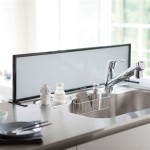Painting a Kitchen Sink: A Comprehensive Guide
Giving your kitchen a fresh look doesn't always require a major overhaul. Sometimes, a simple paint job can dramatically transform the space. While painting a kitchen sink might seem unconventional, it's a practical and stylish solution for updating the look of a worn or outdated sink. With the right preparation and technique, you can achieve a stunning and durable finish that enhances the overall aesthetic of your kitchen.
Choosing the Right Paint
Selecting the appropriate paint is crucial for a successful sink painting project. The ideal paint should be designed for high-traffic areas, resist moisture and stains, and adhere well to metal surfaces. Here are some common paint types to consider:
- Epoxy paint: This durable and long-lasting paint is specifically formulated for metal surfaces. It offers excellent resistance to chemicals, stains, and scratches, making it an ideal choice for kitchen sinks.
- Oil-based paint: Oil-based paints are known for their hard-wearing and moisture-resistant qualities. They offer a smooth and glossy finish, making them suitable for both interior and exterior applications.
- Acrylic enamel paint: This type of paint provides a durable and water-resistant finish. While not as chemically resistant as epoxy paint, it is easier to apply and clean up.
When choosing a paint color, consider the existing kitchen decor and your personal preferences. A neutral color like white or black creates a classic and clean look, while bolder colors can add a pop of personality to the space.
Preparing the Sink
Thorough preparation is essential for a successful paint job. A well-prepared surface ensures that the paint adheres properly and lasts longer. The following steps outline the preparation process:
- Empty and Clean: Remove all contents from the sink and thoroughly clean it with a degreaser or dish soap to remove any grease, grime, or food residue. Rinse it thoroughly with water, ensuring that no residue remains.
- Sanding: Sand the surface of the sink using fine-grit sandpaper to create a textured surface for the paint to adhere to. Pay attention to any rust spots or imperfections, sanding them down until they are smooth.
- Masking: Protect surrounding areas from paint spills using painter's tape. Carefully mask off the sink's drain, faucet, and any adjacent surfaces to prevent the paint from getting on unwanted areas.
- Primer: Apply a primer specifically designed for metal surfaces. This creates a bonding layer for the paint and helps it adhere more effectively.
Allow the primer to dry completely before proceeding to the next step.
Painting the Sink
Once the preparation is complete, you can begin the painting process. Applying thin and even coats ensures a smooth, even finish. Follow these steps:
- Stir the Paint: Thoroughly stir the paint to ensure a consistent color and viscosity.
- Apply Paint: Use a high-quality paintbrush or a roller to apply the paint in thin and even coats. For smaller areas, a brush provides better control. If using a roller, use a foam roller designed for smooth surfaces.
- Drying Time: Allow each coat to dry completely before applying the next coat. Consult the paint manufacturer's instructions for drying times.
- Multiple Coats: Apply two or more coats of paint for optimal coverage and durability.
After the final coat has dried, carefully remove the painter's tape and enjoy your newly painted sink.
Maintenance and Care
To extend the lifespan of your painted sink, follow these care tips:
- Avoid Abrasive Cleaners: When cleaning the sink, use mild dish soap and a soft sponge. Avoid using harsh chemicals or abrasive cleaners that can damage the paint finish.
- Regular Cleaning: Clean the sink regularly to prevent dirt and grime from accumulating. This will help maintain the paint's appearance and protect it from damage.
- Touch-Ups: If the paint chips or scratches, apply a touch-up coat using the original paint color. This will help maintain the sink's appearance and prevent further damage.
Painting your kitchen sink is an affordable and stylish way to rejuvenate your kitchen space. By following these steps and using the right materials, you can achieve a durable and visually appealing finish that enhances the look and functionality of your sink.

How To Farmhouse Sink Diy Painting My Stainless White

Kitchen Sink And Countertop Painting

Let S Paint The Kitchen Faucet Antique Copper My Perpetual Project

How To Paint A Kitchen Sink Homax Tough As Tile Review

July Kitchen Sink Painting By Karin Raba Saatchi Art

How To Repair And Reglaze A Kitchen Sink Using Diy Krylon Tub Tile Kit

What To Paint A Stainless Steel Sink In Your Kitchen With

Kitchen Sink Painting By Joy Nichols Saatchi Art

How To Paint Your Stainless Steel Sink In The Kitchen

Spray Painting A Brass Sink
Related Posts








